by tmoffett | Apr 12, 2012 | Color, Landscape, Photographic Philosophy, Photographic Technique, Uncategorized
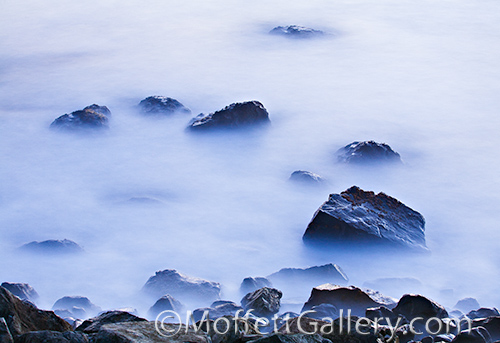
Sea of Mist
I have often said that my favorite time to photograph is just after the sun has set. Well, often I will shoot long after the sun has gone down. This image is one of those times.
It is interesting to me that as many photographers are packing up and going home, I am often just getting started. I like what happens when long exposures capture objects lit with the delicate light coming from the moon. This photograph which is part of my “Shorelines” portfolio, was taken with nearly a 2 minute exposure. The rocks remain tack sharp while the ocean waves crashing ashore become like a sea of mist, soft and delicate. I love how the moisture on the rocks reflects the moonlight and really do look wet, so wet that you can almost feel it when you view the picture. There is also a gentle color shift that I find quite captivating. When I think of the ocean, this is what I see.
If you are a photographer, try not doing a custom white balance sometime. You might just like it! A custom white balance is meant to neutralize the color, making everything look normal, but who is to decide what normal really is. I photograph in this kind of light because of the color, so why would I want to neutralize it? Keeping my white balance in one of the daylight modes will render the colors more closely to how I visualize them instead of removing the color cast caused by the real color of the light that exists, making them appear “normal,” or neutral.
by tmoffett | Apr 10, 2012 | Color, Landscape, Photographic Philosophy, Ramblings
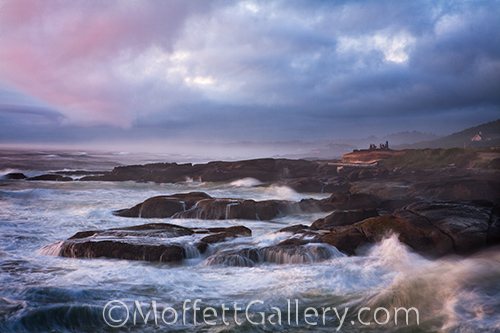
Storm Watchers
Having returned from a Spring Break trip to Moab, Utah, I have settled back in to the routine, sort of. My students are preparing for our big state photography competition that is later this week, my seniors are getting ready for their final show, big projects in my intermediate classes are coming due, personal project deadlines are fast approaching, Spring projects around the house need completed and I am trying to keep my head on straight and not show my stress through it all! This time of year always feels like being on the stormy seas. Then it all will pass and I will begin moving forward again, just in time to have the craziness start all over again. Life seems to get that way frequently for me. Maybe it is just to make me stretch a little. It definitely gets me out of my comfort zone, but always, at least in the past, has been for my good.
I am planning a trip in early May to photograph on the Oregon Coast. The stresses of April will have past and I will be able to find some time for relaxation and regrouping at one of my favorite places on this planet. Even in foul weather on the coast, great photographs await those brave enough to battle the elements. This image attests to that. Enduring the storm and waves, waiting for the perfect clouds, light and waves was a bit miserable, but upon capturing this image, it all became worth it! I have learned that if great effort is made, good things will nearly always be the result. This is not just in photography, but in life itself as well.
by tmoffett | Apr 5, 2012 | Color, Composition, Landscape, Photographic Philosophy, Portraits, Ramblings
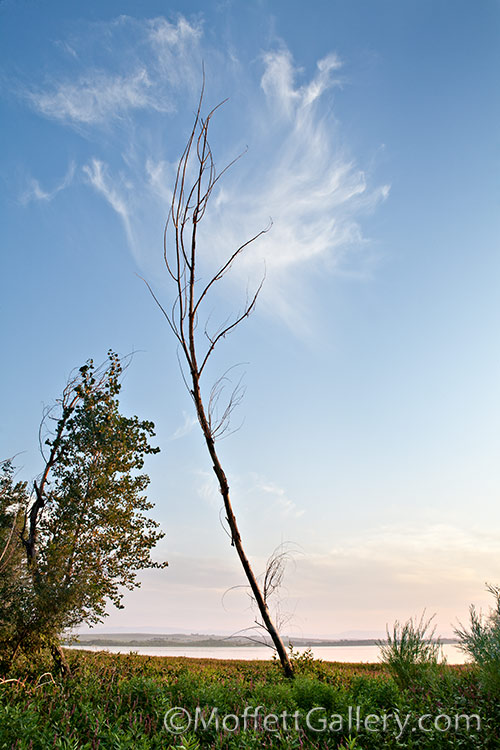
Reaching Upward
While out photographing one evening with a small group of students this image presented itself to me. The students all were hurrying out to the shore of the lake while I took my time observing and enjoying the environment. It was a great teaching moment the next day as I showed the image that everyone had passed up in an effort to get to the final destination. This was my favorite image of the evening. I hope that my students learned something from the experience.
I have learned much from other photographers. Some I have met, others just learned from their photographs. Here a few of my favorite photographers, but by no means is this an all inclusive list. I could list a hundred others who have in some way or another influenced me and my work.
1. Paul Caponigro He will always be on the top of my list. Paul Caponigro is my all time favorite. His images of Stonehenge and other megaliths are very moving. He has a way of really showing emotion in his photographs. I never tire of his photographs.
2. Henri Cartier-Bresson Famed for coining the phrase “The decisive moment.” His simple journalistic style and masterful composition make his images one of a kind. Finding a location and waiting patiently for the right moment to appear in is lens is something that we can all learn from.
3. Yousef Karsh My favorite portrait photographer of all time is Karsh. He had a way of capturing the soul of his subject. This, I believe, can only truly be accomplished by spending time with the subject, which he did. Learning who your subject is and then carefully crafting the portrait with perfect lighting and natural posing are a few of the things that Karsh’s portraits have inspired me to do. A Karsh portrait really communicates.
4. Arnold Newman Another portrait artist whose work has had a great influence on me. He was a master of the environmental portrait with a very simple style.
5. James Nachtwey The importance of being trusted by your subject is evident in his work. His photographs speak for his subjects and can make a difference in the world. Nachtwey brings a very intimate approach to war photography that makes him an advocate for peace.
6. Jay Maisel It’s all about light, shape and color. Find photographs in your everyday world and surroundings. They are there, we just need to find them. That is what Jay Maisel has taught me.
7. Irving Penn I really like his still life images. Simple, yet powerful composition and masterful lighting skills make his photographs some of my favorites.
8. John Sexton His black and white landscape photographs are inspiring. Learning to photograph in the quiet light at the end of the day after the sun has set is something I have learned from the images of John Sexton. Many of his images have a very peaceful, simple look that is very fresh. He is another whose images I never tire of.
My list could go on and on. Everyone has a favorite that could be added, but these are a few of mine. As I look at the work of these eight photographers, the common thread I see that draws me to their work is simplicity. They all have a way of making simple, powerful images. That is something that I have been trying to master for as long as I can remember. The simpler a photograph, the more power that it has. In our complex world, simple is also very refreshing. It is easy to look at. It is peaceful. It communicates. I have learned that by studying the work of other artists and photographers my own work improves. I only wish that I had more time to devote to looking at photographs.
by tmoffett | Mar 29, 2012 | Color, Photographic Philosophy, Photographic Technique
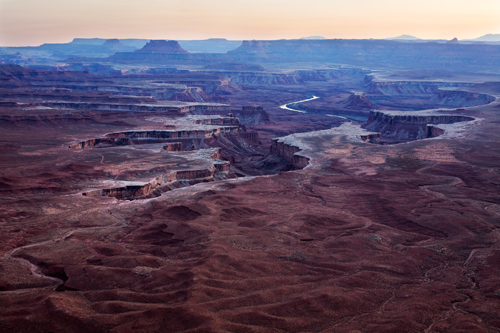
Green River Overlook
The weather in Moab, Utah has been crazy this week. Eighty degrees one day and then freezing cold and 20-30 mile per hour winds the next. The only thing we haven’t seen is storms. Some real storm clouds would be nice. I love photographing with good cloud formations in the sky. Even without the clouds, though, I have had a good time with my family and made a few good photographs as well.
We went to Canyonlands the other evening and stayed to watch the sunset. The sky was real hazy and the wind was whipping as a cold front was moving through, but it brought no real clouds. We drove through the Island in the Sky district and stopped to check out most of the access points to the rim of the canyon. We decided to go to the Green River Overlook area to see the sunset, and I am glad we did! The wind was howling, it was bitter cold and I left my coat at the hotel, there were dozens of photographers battling for prime real estate to shoot from, but the view was spectacular. I photographed until it was too dark to focus the camera and my fingers were too frozen to operate the camera anymore, then we all warmed up on the drive back to the hotel.
The image above is one that I made that night battling the wind and cold. When I got back and looked at the images, I noticed the cool undertones that most of the images had. Interesting for sunset photos, as they usually filled with predominately warm tones. It really showed me how much my own feelings influence how I photograph. I try to absorb my surroundings and make my photographic decisions based on feeling and emotion. This has become my way of working. Even when I am not thinking about it, that is often what happens. It did in Canyonlands that evening. I was working quickly and in a difficult environment, but my emotions took over. This was evident to me in the finished print. When we allow our work to become our way of life, our work becomes personal. That is what will take your work to a new level.
by tmoffett | Mar 23, 2012 | Color, Composition, Landscape, Photographic Philosophy

Clear Night, Arches National Park
It’s Spring Break here in Idaho, and time for another photography field trip! I’ll be photographing near Moab, Utah for the next few days and I am really looking forward to it. These kind of trips are very refreshing and help keep me fresh. It seems like a while since I have been out of my “Home Territory,” and will be a much needed break. I am a real advocate of photographing where you live, however an occasional road trip with the camera will do wonders for the revitalization of the soul.
In anticipation of this trip, I was reviewing some images made from a trip to Moab last summer. I came across this panorama that I shot at the end of the day when it was just about too dark to even focus the camera. That is one of my favorite times to shoot. It was a cloud free night and I found this horizon line to be quite interesting. It looked kind of like my lifeline, some ups and downs, maybe some bumps and bruises, yet constantly moving forward. I usually like a few good clouds, but this image, with its clean and simple design works just fine. God is the ultimate designer, and if we are observant enough, can find the beauty in whatever He places in front of us. That is the challenge. Find the beauty in the chaotic world in which we live. It is there. We must just simplify our vision in order to find it.
by tmoffett | Mar 21, 2012 | Color, Landscape, Photographic Philosophy, Photographic Technique
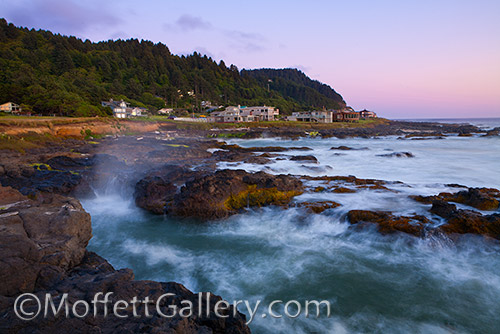
View From Ocean Drive, Yachats, OR
Photography means writing or drawing with light. Knowing this, it would then make sense that the better the light, the better the photograph. As simple as this concept may seem, it is sometimes hard to get students to understand it. So often I hear students in the process of researching other photographers work question why their own images don’t look more like the professionals. More often than not it comes down to light. You may be in a great location and have a great composition, but without great light you’ll end up with a mediocre photograph.
As the sun moves across the sky the color and quality of light that reaches the surface of the earth changes. The warm, soft light at sunrise turns to a cool and harsh light with deep shadows by mid-morning on a cloud-free summer day. By late evening the warm, soft light with rich, open shadows returns and slowly change to a soft cooler light after the sun sets. Coming to know these changes and learning to recognize what light quality will produce the mood and feeling that you want to elicit in your finished photograph are key to creating powerful images. For landscape photography, more often than not the early morning or late evening will produce the most desirable result.
There is one time of day that is often forgotten when it comes to making photographs; after the sun has set. I will often arrive at a location and watch as others are packing up and leaving and I am just getting started. A tripod is a must for making photos after sunset, but the mood and feeling rendered can be quite unlike anything that can be captured during the day. I will work many times until it is too dark to focus the camera.
The image above was taken just after sunset. You can see the warm pastel colors on the horizon, shifting to cooler tones in the upper sky. The warm light still on the horizon skims across the surface and illuminates the west face of the rocks and the buildings, while the cooler light from above illuminates the shadows and reflect off of the water. These subtle shifts in hue are what create some of the drama and interest in this image. Being patient and waiting for the right moment to press the shutter is much of what photography is about. Ansel Adams said, “Sometimes I do get to places just when God’s ready to have somebody click the shutter.” I believe that Ansel Adams had a very good understanding of light and placed himself at the right places and at the right times to take advantage of the beauty that God put in front of his lens.








Recent Comments